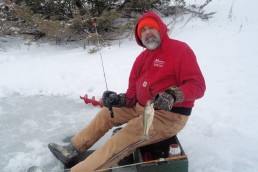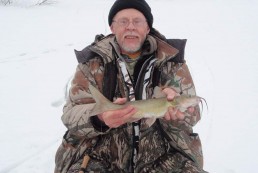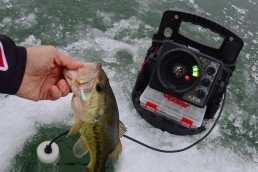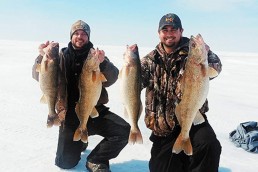Old-fashioned Ice Fishing Still Puts Fish on the Plate
SHARE THIS POST
Since immemorial winters, man has been trying to catch fish that swim below the frozen cover of ice on ponds, rivers and lakes. Paleolithic hunter-gatherers took rocks, antlers or whatever they could find, knocked holes in the ice and then dropped 1-inch-long fragments of chipped stone that were tied on braided vines and baited with meat.
It didn’t take long for them to discover which portions of the lakes held fish and at what depths. The fish bit the long, thin, sharpened stones and were hauled up, clubbed on the head and became the next meal for hungry families. During the more sophisticated ages, man used iron axes and iron fish hooks tied on to braided silk or braided catgut to catch their fish. Wooden sleds were also used to carry their gear and enough food to last a day. And at nightfall, those same sleds carried the fish they caught back to their homes. There are some days now when the “old-fashioned” ice fishing is as welcome as the first breath of spring. I’m talking about those sunny days in winter when the ice is still thick enough to be safe on, the wind isn’t blowing and there’s enough snow on the ice to reflect the sun’s rays and a guy can just sit out in the open and fish.
Now, it’s not uncommon to see an angler head out onto the ice on a quad or snow machine towing an ice shanty that can be erected or taken down in minutes, especially after the angler deems it necessary to relocate to a better area. And, once that shanty is erected, out comes the power auger and a number of holes are drilled. A fish finder is installed in one hole as well or other underwater-viewing devices long before a school of fish is located. Next, out comes the propane heater for the tent and the angler settles back in a padded seat for a comfortable experience.
I find no fault in this type of ice fishing; I enjoy the heck out of my ice cabin, my StrikeMaster electric ice auger, my IceArmor clothing and boots, etc.—I wouldn’t give up any of them for the world. But for days when conditions are ideal enough to be out of the shanty though, I’ll only pack a couple of rods, a pair of needle-nose pliers, a box of jigs, a few spoons, some extra line, an ice skimmer, a camera and hot chocolate into my sled and head for a small farm pond. I still use that auger though, which can be easily attached to the sled.
Are you enjoying this post?
You can be among the first to get the latest info on where to go, what to use and how to use it!
Once the holes are drilled and the depth is determined, I’ll use a clip-on weight and I’ll also tie on a tiny jig and tip it with a waxworm, suspend it below a very small bobber and simply drop it into the hole. My other rod is adorned with either a Rapala Jigging Minnow or a Northland Buck-Shot Jig. For both, the hooks used are dressed up with a small Gulp Alive Minnow that looks, acts and smells like something that is good to eat.
I let the fish tell me what they prefer. If there are no strikes on the jig as it’s deadsticked, I’ll impart some jigging action by raising and lowering the rod tip. If nothing, then I’ll try the same techniques at a slightly different depth. Some days the fish are deep and some days they’re very high in the water column, even just inches under the ice. With either a Rap or a Northland Spoon, my initial approach is to lift and drop the lure, at first with a slow, subtle action, and then increasingly quicker if there are no takers. Sooner or later, one of these techniques will put fish on the ice, if they are there at that hole. If not, then it is a simple matter of packing up my sparse gear and moving.
Besides the obvious benefits of catching some tasty, fresh fish for the plate, sitting out in the fresh air the old-fashioned way affords me some great opportunities to observe Mother Nature at her best. My little pond is quite near a large river where eagles are often seen flying, white-tailed deer are in abundance, and where coyotes, foxes, mink, red-tailed hawks, Canada geese and several other species are inhabiting the wild. If I remained inside an ice cabin I would not necessarily see them all.
The winter months can, at times, offer some very accommodating weather for those who want to sit outside and ice fish. Remember to slap on some sunscreen, use a pair of sunglasses and have some fun on the ice the traditional way out in the open.
MWO
SHARE THIS POST
Did you enjoy this post?
You can be among the first to get the latest info on where to go, what to use and how to use it!
John Bennett
John Bennett is a retired history teacher, historical re-enactor, father and grandfather. As a four-season outdoorsman, his passion is waterfowl hunting and fishing for smallmouth bass. He lives in Ohio and spends quite a bit of time in his primitive log cabin, which he built.




